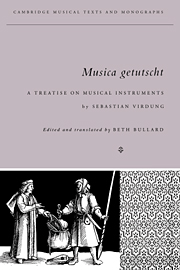Book contents
- Frontmatter
- Contents
- Preface
- List of abbrevations
- PART I TRANSLATOR'S INTRODUCTION
- 1 Why study Musica getutscht?
- 2 A biography of Sebastian Virdung
- 3 The publication history of Musica getutscht
- 4 The offspring of Musica getutscht
- PART II MUSICA GETUTSCHT
- Appendix Transcriptions of documents pertaining to Sebastian Virdung and Musica getutscht
- Notes
- Bibliography
- Index
3 - The publication history of Musica getutscht
Published online by Cambridge University Press: 14 August 2009
- Frontmatter
- Contents
- Preface
- List of abbrevations
- PART I TRANSLATOR'S INTRODUCTION
- 1 Why study Musica getutscht?
- 2 A biography of Sebastian Virdung
- 3 The publication history of Musica getutscht
- 4 The offspring of Musica getutscht
- PART II MUSICA GETUTSCHT
- Appendix Transcriptions of documents pertaining to Sebastian Virdung and Musica getutscht
- Notes
- Bibliography
- Index
Summary
Musica getutscht survives in two separate editions, the original of 1511 (source of all facsimile editions to date) and a copy brought out sometime before 1521. Following Edwin Ripin's designations, scholars generally refer to the former as “printing A” and the latter as “printing B”. As noted above in Chapter 2, although neither edition indicates printer or date of publication, the author's dedication (sig. A2v) gives Basel as the original place of publication and 15 July as the date that Sebastian Virdung presented this part of the copy to his printer. Internal evidence (the type font, initials, and ornamental borders) as well as external evidence (Schlick's identification in his Tabulaturen Etlicher lobgesang) point to Michael Furter as the man responsible for bringing the first edition of this work to the public. Since the passage in which Schlick named Furter was dated 30 November 1511, the publication date of Musica getutscht can be placed in that year between 15 July, when Virdung presented his dedication to Furter, and sometime before the following fall. An estimated date of middle or late summer would thus allow time for the blind organist to have gained access to Musica getutscht, to have had it read to him, and to have prepared a response by the end of November.
The format of Musica getutscht requires comment, as it has been described variously as quarto, octavo, and even duodecimo.
- Type
- Chapter
- Information
- Musica GetutschtA Treatise on Musical Instruments (1511) by Sebastian Virdung, pp. 47 - 60Publisher: Cambridge University PressPrint publication year: 1993



